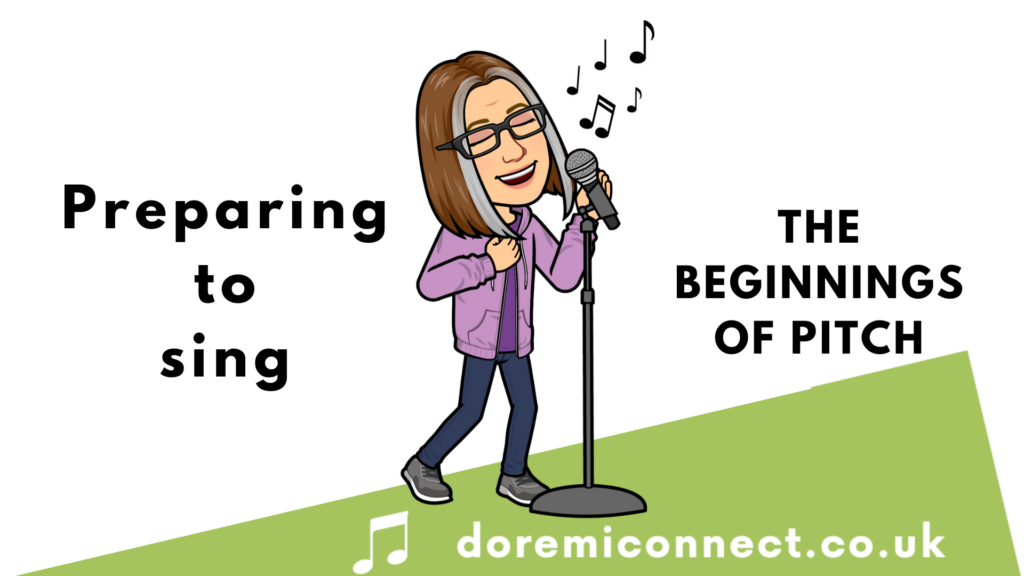Preparing to Sing: The Beginnings of Pitch

I wanted to discuss pitch in the blog after beat and rhythm, but the beginnings of pitch aren’t anything to do with so and mi or high and low; it’s about experiencing the voice and children determining whether something is singing or speaking. They need opportunity to play games and do activities to prepare voice types and to make them feel comfortable with using their voice in different ways.
So let’s explore the things we need to consider before diving into pitch…
What is Singing?
An important question for Kodály teachers since it is the cornerstone of this way of teaching music!
Singing is the act of creating musical sounds with the voice – that’s pretty much it! Basically, we’re making music with our voice. It could be rhythmical, pitch or more…
What about speech?
It’s too simplistic to say that singing uses pitch and speaking doesn’t. Pitch is involved in speech too: for example, children speak with a higher pitch than adults. The adult larynx is larger and testosterone lowers the voice further by thickening the vocal folds.
We also change our pitch in speech through inflection, when our moods change or for effect. We can make the pitch of our voices go up at the end of a sentence when asking a question, our voice might go higher if we’re anxious, frightened or excited. We can also make musical sounds using a speaking voice!
In considering only these few points, it’s clear to see that there isn’t such a clear-cut distinction between singing and speech.
The blurred line between speech and singing
Although we tell our students that we use a singing voice for songs and a speaking voice for rhymes, this is to help them to access a singing sound. It’s not really as straightforward as that!
For example, pop and musical theatre styles of singing use a speech quality thick fold sound. Belting, for example, is done with a speech basis taken into higher pitches.
What’s the difference between speaking and singing?
Try making a singing sound, perhaps sing through See Saw. Then say the rhyme Cobbler Cobbler. You’ll probably find the singing voice you used has a very different timbre to your speaking voice.
For speech or rhyme, the speaker determines the pitch. When saying Cobbler Cobbler, did you notice where you raised your pitch? On which words did you use a raised pitch? You will have chosen where to use inflection, whereas in singing, the melody attached to the song determines the pitch.
Rhymes tend to be said in a lower pitch and have a smaller range of pitches. In singing, the melody determines the pitch. Whether it’s by a composer or a traditional song, the melody attached to it determines the pitch. Think about what happened when you sung See Saw; was there much scope for changing the pitch without changing the song?
The range of pitches used in songs and rhymes is also different: songs generally use a higher pitch with a larger range whereas rhymes, although they have pitch through the use of inflection, the pitches tend to be lower and a smaller range.
A further distinction is the vowel to consonant ratio. In rhymes it is around 5:1 because we are prioritising articulation, making more use of the closed sound of consonants. When singing, we elongate the vowels because we want to prioritise resonance and enjoy the pitches and melody. This creates a vowel to consonant ratio around 200:1.
Considering the blurring of the line between singing and speaking, if using a speaking voice to sing, like in a pop or musical theatre sound, we’re still elongating vowels and finding resonance, but the timbre when singing with a speech quality is not going to be the same as singing with a choral quality to blend in with the other singers.
In my next blog post I’ll talk more about children’s voices and what we need to consider as Kodály practitioners… well, all teachers who ask our students to explore voice types actually! In the meantime, let me know your thoughts on the distinction between singing and speaking.
[…] previously discussed what we can do to prepare children to sing and how to help children sing confidently, but we also need to understand what pitch actually is! […]